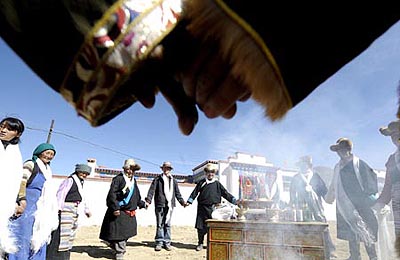| A prominent Indian journalist on Wednesday rejected Tibetan independence "propaganda", saying the region's economic growth was good and atmosphere was "relaxed".
 |
|
Tibetan villagers dance during a celebration for moving into new houses in Kunggar Town of Maizhokunggar County in Lhasa, capital of southwest China's Tibet Autonomous Region, Feb. 11, 2009. (Xinhua Photo) | "Problems are largely in the minds of some sections abroad, 'make-believe Tibet', and the propaganda of the pro-independence movement of Dalai Lama," Narasimhan Ram, editor-in-chief of The Hindu, a leading English-language Indian daily, told Xinhua on Wednesday.
Ram's comments came after he concluded a two-day trip to the southwest China's Tibet Autonomous Region earlier this week. It was Ram's third visit to Tibet since 2000.
"People always asked why I went to Tibet again and again," Ram said, attributing the visits to his intention to "check the reality".
Ram described how the Dalai Lama and the Tibetan government-in-exile were active in India, claiming Tibetans were made minorities by the Han people and proclaiming a greater Tibet with a population of 6 million.
Ram has traveled to various parts of the region, from the capital city of Lhasa to underdeveloped villages. He has seen schools, monasteries, orphanages and factories.
"The reality is that Tibet is on the road economically and the atmosphere there is relaxed, not tense at all," Ram said.
"Tibet is remote for ordinary Chinese. You must be a fool to say Tibetans are a minority," Ram said.
The total population of the region hit 2.84 million in 2007, with Tibetans accounting for 92 percent, according to official figures.
Ram said the problem facing Tibet was the economic slowdown as the world financial crisis took its toll on the region.
"But the growth rate of Tibet is still good, up about 10 percent per year, much higher than other parts of the world."
Ram's latest visit coincided with the run-up to the Tibetan New Year. "We witnessed fewer people in work places as they went back home to celebrate the New Year," Ram said.
He said there was no sign of strain or suppression there as people were filled with excitement and the atmosphere was festive.
"There were plenty of signs of prosperity on my long drive from Lhasa to Nyingchi," Ram said.
Of the region's move to commemorate the end of feudal serfdom every year on March 28 -- the day the Chinese government dissolved the aristocratic local government of Tibet and freed more than 1 million serfs in 1959, he said, "It is a good decision."
"There were serf systems in many countries, but it was worse in Tibet," Ram said.
"The contrast between the old and new is very powerful, demonstrating what the Chinese government and the system have done for Tibet."
(Xinhua News Agency February 25, 2009) | 